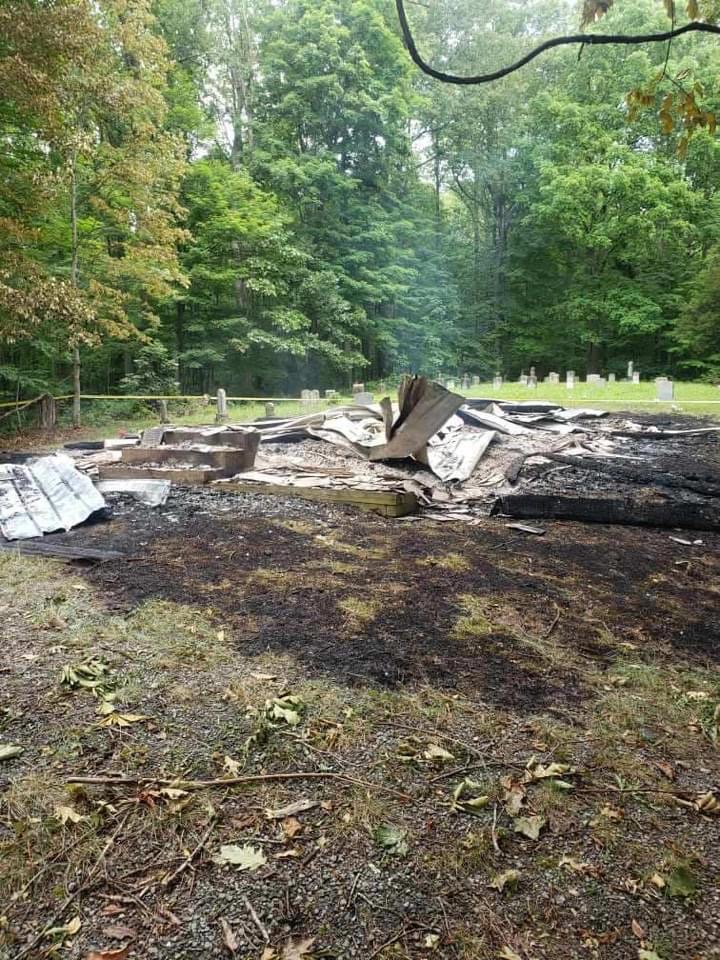SHADY SPRING, West Virginia — Fire Chief Jason Redden said that by the time he and his crew had arrived with their equipment along the steep grade where St. Colman’s has sat proudly perched on Irish Mountain, nothing was left of the iconic chapel.

“There were a few smoldering embers, but that was it. It was all gone,” he said. “The church had just been completely erased from its existence.”
Redden, a Raleigh County deputy sheriff and paramedic as well as the chief of the Beaver Volunteer Fire Department, comes from a family that has called Raleigh county home for several generations. He said St. Colman’s was known as the “little church on Irish Mountain” and had been a special part of the community for over 150 years, providing people for centuries not just a place to worship but also illustrating an important part of the grit and purpose of the region’s history.
Sadly, the church and all its history were evidently destroyed in a deliberate act of arson.
St. Colman’s never was much a grand structure or parish. It probably never drew more than 40 souls to Mass on Sunday. It was covered in white clapboard over a hundred years ago, and underneath the veneer was a simple log cabin structure built by the Irish immigrants who settled here just after the Civil War to build the railroad.
You can see the remnants of the logs under the ash. The scent of the blaze hangs heavy over the area leaving an eerie mist laying like a gray shelf over the graves of the men and women who built this simple place to practice their faith after a long week of laboring on the tracks in the valley below.
Tim Bishop, who does communications for the Diocese of Wheeling-Charleston, said St. Colman was a relic of Appalachian history and the region’s immigrant story. “It is so sad that those doors will never open again, that no one will be able to sit in her humble but beautiful pews, worship God, and be a part of something bigger than themselves, to be a part of the history of our country, her people, and the pursuit of worship.”
Bishop explains the parish had its roots in an era when West Virginia was still part of Virginia. Maurice Sullivan, an Irish immigrant, bought the first parcel of land. Soon, several other families settled here as well, and the mountain became a community. It remains as isolated today as it was 150 years ago. Thick forests and the New River in the valley below required the immigrants who settled here to be self-sufficient — including in their Sunday worship.
“They were a distinct ethnic group who all practiced the same faith but had nowhere to do that,” Bishop said. “The nearest parish was St. Patrick’s, which was located in Hinton, down a perilous dirt mountain road over 15 miles away. So Sullivan donated an acre of his land to the Diocese of Wheeling for the establishment of a church and cemetery.”
There were never more than two dozen families who lived and worshiped here. By the turn of the 20th century, it was less than that. The able-bodied men had left to find work elsewhere. By 1984, St. Colman’s went from a parish to a chapel with a historic designation, awarded by the federal government as a historic site.

Bishop said St. Colman’s still held special services up until the fire and had been maintained by the parishioners of St. Patrick’s. Visitors could walk in and sign the guest book and walk around and note the care that went into the building of the pews and altar. I toured the place with my own children several years ago.
Sen. Joe Manchin (D-WV), a practicing Catholic, said it was heartbreaking to see the destruction of a parish with such a powerful story. “It is devastating to think someone would target a place that means so much to so many,” he said. “I hope whoever committed this crime is brought to justice.”
Behind where the church once stood is a cemetery — the final resting place of so many early immigrants and their decedents. Bishop said it will still be maintained with care by the Diocese of Wheeling-Charleston.
One sentinel had the most prolific inscription: “Remember kind friends as you pass by/As you are now so once was I/As I am now, so you must be/Prepare for death, and follow me.”
In 2016, Samantha Shepard wrote a piece on St. Colman for the Appalachian Studies Association, citing that inscription. At the time, she speculated that the church would remain a visible reminder of the once-vibrant immigrant community that called this mountain home.
That reminder is now gone. It is hard to imagine the hostility toward faith and history required to commit such a crime. Let us hope that the mountains give up the secret of the guilty party.

